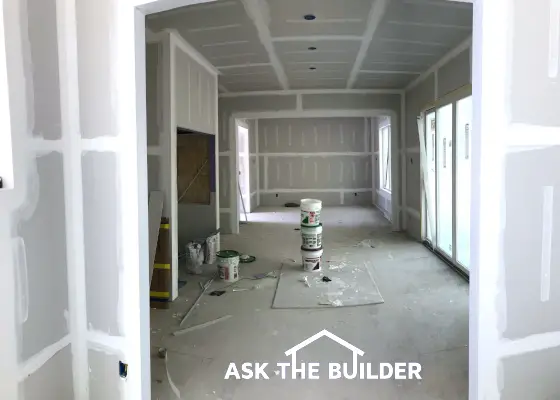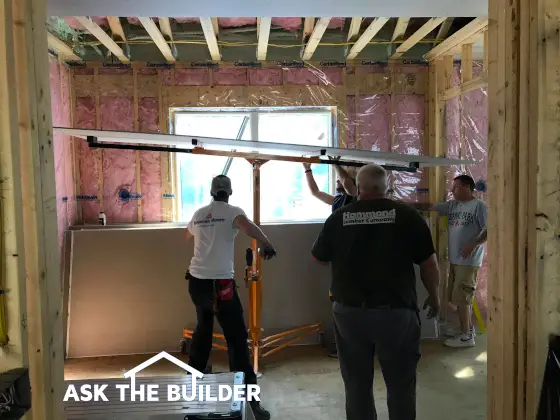How Hard Can Drywall Be?

How Hard Can Drywall Be? | This is drywall being finished in a new home. The sheets are heavy and you need hand-eye coordination to finish it. (C) Copyright 2019 Tim Carter
How Hard Can Drywall Be? Is it that hard?
QUESTION #1: I’m building a new home and because of the booming economy and shortage of great help, I might be forced to hang and finish the drywall myself. I’ve done a few repairs here and there and wonder if it’s really possible to pull off DIY drywall work on a larger scale. Don’t sugarcoat it. I need to know what I’m getting myself into. Steve B., Spotsylvania, VA
Steve’s in the same boat as one of my new neighbors on my street. A young NH state trooper bought a lot here a year ago and broke ground this spring hoping to move his two kids and wife into their new home by Thanksgiving. He discovered six weeks ago that the rough carpenters he was counting on to frame the house and get it under roof abandoned him. He couldn’t even get others to answer his calls for quotes.
Guess what? This homeowner is framing the house himself with some occasional help from friends. He’ll be lucky, at the rate he’s going, to have it under roof by Thanksgiving.
How Do You Hang Drywall Sheets?
Drywall work is hard. The hanging of the large heavy sheets is mind-numbing. You can rent or purchase mechanical lifts that hold the sheets up to save your back should you proceed. I’d absolutely do this because any helpers you conscript will not have the required experience to hold a giant sheet overhead while securing it to the ceiling joists.

Large sheets of drywall are very heavy. You can rent machines that hold the sheets up against the ceiling. (C) Copyright 2019 Tim Carter
An experienced drywall hanging crew might install all the board in just two days. It could take you two or three weeks as you start to develop speed and accuracy. It’s important to realize you must use the correct screws, they must be the right length, the spacing between fasteners is critical, and by all means, you must not overdrive them tearing the tender drywall facing paper. All the information about this can be found in the Gypsum Construction Handbook published by the USG Corporation.
How Do I Finish Drywall?
Once the drywall is hung, then you need to finish it. I’m convinced, after watching many try to do this on countless job sites, that not everyone possesses the required hand-eye coordination to finish drywall as a pro might do. You have no idea the muscle memory you need to master to not only tape the seams the first time but then also apply the all-important second coat just right.
The consistency of the vinyl taping and finishing compound is critical. You can’t have it too stiff and if you add too much water, you dilute the water-based glue that’s part of the product. Many finishers strive for a consistency that’s close to warm cake icing.
Taping drywall looks easy. It’s not. The most common mistake is to remove too much of the joint compound from under the tape. If you do this, the tape will blister when you go to apply the second coat. Your goal is to leave just under 1/16th inch of drywall taping compound under the tape. Once again, refer to the Gypsum Construction Handbook for guidance.
Let’s assume you successfully tape all your new drywall. Now comes the most challenging part. You need to cover over the tape with a second layer of finishing compound. I can’t begin to explain how difficult this is to get right. To add further misery, there’s a very specific methodology to what flat and tapered seams and which side of inside and outside corners get coated the first day. You don’t want to run into a situation where you’re trying to apply a second coat at the same time where a flat seam intersects an inside or outside corner.
The edges of the second coat must be feathered to nothing. This requires you to bend the blade of the finishing knife you’re using. Press too hard and you’ll scratch the paper facing. Apply too little pressure and you’ll probably leave a little too much compound on the wall. Don’t forget, all new finishing knives have to have the sharp corner filed down ever so slightly!
You don’t want to leave too much compound humped up in the middle of seams. This will show up at night when light travels at a low angle across the walls and ceiling. Butt seams where the ends of two sheets of drywall touch one another are an extreme challenge. You’re forced to hump up the finishing compound higher than the unfinished drywall and it needs to be feathered out about one foot either side of the center of the seam to make this buildup invisible.
Some professional drywall finishers skim coat all of the drywall after everything is sanded. This extra step fills in the tiny void spaces in the paper facing of the drywall. The entire wall and ceiling surface then has the same sheen and texture when you paint. You can purchase special paints that eliminate the need for skim coating new drywall.
If you’re in the same situation as Steve and my neighbor, I wish you the best of luck and know one thing: Elephants are best eaten one bite at a time.
Column 1315